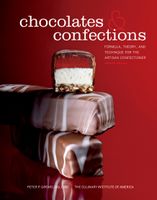Advertisement
By Peter Greweling and Culinary Institute of America
Published 2007
Colors for confectioners are divided into two categories: fat-soluble and water-soluble. Fat-soluble colors are used for coloring chocolate or cocoa butter. They are designed to dissolve in fats and so are ideally suited for use in chocolate. Fat-soluble colors are commonly found either in a liquid form that is predissolved in oil or cocoa butter or in a powder form that must be dissolved. The predissolved form is slightly more convenient to use, but similar results can be obtained from either variety. When dry colors are used, they must first be dissolved in a small quantity of cocoa butter, which is then mixed into chocolate or more cocoa butter for application. Dry colors are often difficult to dissolve fully and can require agitation and grinding. For this reason it is advisable to prepare a quantity of colored cocoa butter in advance that can simply be melted and used when needed.



